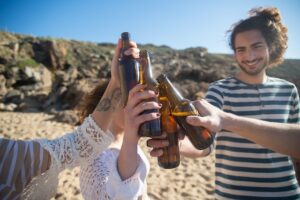 The effectiveness of alcohol interventions is measured by reducing the use of alcohol with risk patterns in individuals with low levels of dependence ( Ayala et al., 1998 ). The PIBA has been empirically shown to be cost-efficient through the implementation of randomized clinical trials in adolescents with legal and illegal drug use problems, in urban and rural populations of our country and for periods longer than six months ( Martínez, 2003; Martínez et al . al., 2008 )
The effectiveness of alcohol interventions is measured by reducing the use of alcohol with risk patterns in individuals with low levels of dependence ( Ayala et al., 1998 ). The PIBA has been empirically shown to be cost-efficient through the implementation of randomized clinical trials in adolescents with legal and illegal drug use problems, in urban and rural populations of our country and for periods longer than six months ( Martínez, 2003; Martínez et al . al., 2008 )
Among the limitations of this study, the sample was not randomized, and the results obtained were not contrasted with a control group. Future research is proposed to investigate variables such as adherence to treatment, new technological modalities of brief Intervention, and effective components in brief interventions.
Although not all adolescents managed to complete the brief Intervention, many of them managed to maintain positive results, probably because they all participated in the following stages of the PIBA: admission, evaluation, induction, and the first session of the intervention phase, decisional balance. The decisional balance seeks to consider the pros and cons of substance use; it can reduce ambivalence and lead young people to reduce or stop using substances. Given the above, it would be plausible to think that the pre-treatment phases, added to a PIBA treatment session, help young people decide to change without completing the entire program.
Procedure
The PIBA Is Designed To Be Applied In Four Stages:
- Admission, in which it is determined whether adolescents are candidates to receive the Intervention.
- The evaluation, with which an assessment of the history of consumption and its pattern in the last six months is made; It also serves to identify the main risk situations that lead the user to consume, as well as their level of perceived self-efficacy and their idea of the severity of consumption.
- Induction to treatment, with which the adolescent is motivated to change their consumption behavior to remain and adhere to the treatment; Motivational interviewing techniques are used at this stage.
- The Intervention is divided into several sessions. First, a balance is made between the advantages and disadvantages of consuming psychoactive substances, the reasons the participant has to change are listed, and a treatment goal is established. In the second, risk situations are identified, and strategies for change or action
 plans are developed with the participant. In the third, the goals the participant wants to achieve in the short and long term are identified, and how consumption influences them is analyzed. In the fourth, the participant is given feedback on the changes achieved, a second consumption goal is established, and it is planned how it will be maintained once the treatment is finished. These sessions are held once a week in an individual format and the follow-ups
plans are developed with the participant. In the third, the goals the participant wants to achieve in the short and long term are identified, and how consumption influences them is analyzed. In the fourth, the participant is given feedback on the changes achieved, a second consumption goal is established, and it is planned how it will be maintained once the treatment is finished. These sessions are held once a week in an individual format and the follow-ups
Users who came to CPAHAV for the first time underwent an initial assessment; Those who met the PIBA entry requirements began the Intervention. Those who were not candidates were channeled to other institutions.
With those adolescents who were included in the PIBA between 2010 and 2014, a follow-up and an interview with collateral were carried out. In total, 60 complete follow-ups were carried out on adolescents together with their respective collateral; five were done in person and 55 over the phone.
Thirty adolescents completed the brief Intervention and were discharged; the other 30 failed to complete the Intervention but completed the initial assessment and attended at least the first session (decisional balance and goal setting). Once the users attended their scheduled appointment or agreed to conduct the follow-up interview, they signed the informed consent, which they read over the telephone. Each participant was informed that the follow-up data is confidential and would be used for research purposes; They were also told that the purpose of follow-up is to support users in the change process after treatment.…